Written By: KRUPA K VARGHESE : Is Bamboo A Tree
INTRODUCTION
Bamboo, though taxonomically a grass, was considered under the category of “trees” as per Section 2(7) of the Indian Forest Act, 1927. Hence, many regulatory limitations were applied to Bamboo, especially in cutting and transportation. It would have been exempted from any such restrictions if it were considered as “grass”.
Being the fastest growing plant on earth, bamboo requires no fertilizers or pesticides during cultivation making it a highly renewable and eco-friendly material. It can be used for several purposes ranging from clothing, musical instruments, toys to medicinal usage.
In 2017 The Indian Forest Amendment Act was passed by the government. The Act has amended the earlier act to exempt felling and transportation of bamboo grown in non-forest areas from the state permit. It has omitted bamboos grown in non-forest areas from the definition of trees. Thus, after 90 years, with the government amending the Indian Forest Act and axing the bamboo from a list of trees, it has legally ceased to be a tree.
WAS THE AMENDMENT REALLY NECESSARY?
The bamboo resources in India are much higher compared to other countries in the world. Commonly called the green gold and poor man’s timber, bamboo has a variety of uses.
Bamboo shoots are even taken as a dietary supplement in some parts of the country. But the farmers were not able to utilize the entire benefits of bamboo as it was legally considered as a “tree”.
For several years, 90 years to be precise, the ferry of bamboo across the state borders was limited. Permits from village councils were required for the same. Also, the cultivation of bamboo in non-forest areas was restricted. This was because bamboo was considered under the category of “tree” according to Indian Forest Act,1927 until an amendment was passed in 2017.
The main and most important reasons why this amendment was made are:
- To increase the income of farmers.
- To increase the green cover of the country.
Even though bamboo is highly renewable and reusable, if it is not harvested every year, it affects the productivity of the plant on account of the congestion. Also, the shooting of new culms would be retarded.The source of origin of bamboo may be either forest or non-forest areas. It is almost impossible to distinguish the source of origin of bamboo once it is harvested and stored somewhere. So, practically, any restriction on its storage and transit would definitely affect private cultivators.
IMPACT OF THE AMENDMENT
The amendment has given back bamboo its logical and long overdue status. Bamboo must be harvested every year unlike timber which is harvested on cycles that range from 8 to 9 years for some species to 40 to 60 years for others.
Harvesting of bamboo entails cutting off only a few mature culms, leaving the majority part of the plant, which includes rhizome and root structure, to re-grow and perform significant environmental and ecological functions in the ecosystem. This is another factor that distinguishes bamboo from timbers.
A remarkable change was brought in the archaic Indian Forest Act, 1927 with the approval of the ordinance. It was welcomed by common men as it fulfilled the demand of millions of farmers who were growing bamboo in their private land for livelihood or for upkeep.
The earlier rules provided in the Act did not even allow growing of bamboo in farmlands, beyond a subsistence level, to meet the raw material requirement of craftsmen and businessmen who are involved in generating millions of jobs in rural areas.
Appreciably, the amendment played a major role in the use of bamboo in high value products and applications. Modern technological developments have the capability to transform the sector. If all the useful breakthroughs in technology are effectively incorporated in the Indian bamboo sector, it would not only broaden and enhance ancient livelihood patterns, but also mold the bond between the organised and unorganised sectors.
Another significant impact of the amendment
It provided job opportunities to many. The present demand of bamboo in our country is approximately 28 million tonnes
A single tonne of bamboo provides 350 man days of work and an enabling situation for the cultivation of bamboo will help in creation of job opportunities all over the country. As per the data provided by United Nation Industrial Development Organisation (UNIDO), the bamboo business in the North-East region alone has a value of about INR 5,000 crore in the next 10 years.
With a view of the chance of economic utilization of bamboo, the government of India launched the National Bamboo Mission (NBM) in 2006. It was renamed as National Agro-Forestry & Bamboo Mission (NABM)in 2017 by the government. The Department of Science and Technology (DST) implemented the National Mission on Bamboo Applications (NMBA), to provide propulsion to the bamboo sector and to ease the recognition of its substantial future. But, NMBA ceased to be a mission in 2014. It is to be noted that all these steps were taken by the government to support and broaden the bamboo sector in India.
CONCLUSION
Before the amendment of the Indian Forest Act in 2017, almost 12.6 million hectares of land in India were under the category of “cultivable waste land”. India’s enormous potential was not well utilised to increase our country’s share in the global bamboo market.
The amendment encouraged farmers and other individuals to take up a plantation or block plantation of appropriate bamboo species on cheap and degraded land. In addition to that agricultural land and other private lands under the agro-forestry mission were also utilized for the same purpose.
An ordinance under Article 123 of the Constitution of India to amend Indian Forest Act, 1927 was promulgated by President Ram Nath Kovind to encourage bamboo plantation by farmers in private lands. It is now expected that by the year 2022, the income of bamboo farmers will be twice as it was before the amendment. However, even now, the bamboo grown in forest areas continues to be governed by provisions of the Indian Forest Act, 1927.
Also Read: Fundamental Rights And Supreme Court’s Views
REFERENCES




Leave feedback about this